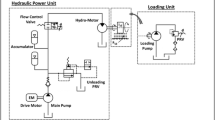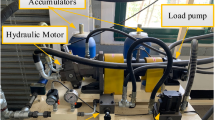Abstract
A new hydraulic closed-loop hydrostatic transmission (HST) energy-saving system is proposed in this paper. The system improves the efficiency of the primary power source. Furthermore, the system is energy regenerative, highly efficient even under partial load conditions. It can work in either a flow or pressure coupling configuration, allowing it to avoid the disadvantages of each configuration. A hydraulic accumulator, the key component of the energy regenerative modality, can be decoupled from or coupled to the HST circuit to improve the efficiency of the system in low-speed, high-torque situations. The accumulator is used in a novel way to recover the kinetic energy without reversion of fluid flow. Both variable displacement hydraulic pump /motors are used when the system operates in the flow coupling configuration so as to enable it to meet the difficult requirements of some industrial and mobile applications. Modeling and a simulation were undertaken with regard to testing the primary energy sources in the two configurations and recovering the energy potential of the system. The results indicated that the low efficiency of traditional HSTs under partial load conditions can be improved by utilizing the pressure coupling configuration. The round-trip efficiency of the system in the energy recovery testing varied from 32% to 66% when the losses of the load were taken into account.
Similar content being viewed by others
References
D. Manring and G. Luecke, Modeling and Designing a Hydrostatic Transmission With a Fixed Displacement Motor, ASME, 120 (1998) 45–49.
A. Njabeleke, R. Pannett, P. Chawdhry and C. Burrows, Self Organising fuzzy logic control of a hydrostatic transmission, UKACC International Conference on control, UK. (1998).
Y. Jen and C. Lee, Robust speed control of a pump controlled motor system, IEE proceeding, 139(6) (1992) 503–510.
M. Martelli and L. Zarotti, Hydrostatic Transmission with a Traction Control, 22nd ISARC, (2005).
H. Schulte, Control Oriented Modeling of Hydrostatic Transmissions using Takagi Sugeno Fuzzy Systems, Fuzzy Systems Conference, FUZZ-IEEE 2007, IEEE International, (2007).
K. Dasgupta, Analysis of a hydrostatic transmission system using low speed high torque motor, Mechanism and machine theory, 35 (2000) 1481–1499.
R. Kordak, Hydrostatic Drives with Secondary Control, Bosch Rexroth AG, (2003).
A. Pourmovahed, N. Beachey and F. Fronczak, Modeling of a Hydraulic Energy Regeneration System — Part I: Analytical Treatment, ASME, 114 (1992) 155–159.
A. Pourmovahed, N. Beachey and F. Fronczak, Modeling of a Hydraulic Energy Regeneration System — Part II: Experimental Program, ASME, 114 (1992) 160–165.
J. Hao, S. Ikeo, Y. Sakurai and T. Takahashi, Energy Saving of a Hybrid Vehicle Using a Constant Pressure System, JFPS, 30(1) (1999) 20–27.
Y. Yen and C. Lee, Influence of an Accumulator on the Performance of a Hydrostatic Drive with Control of the Secondary Unit, IMechE., 207 (1993) 173–184.
J. Lumkes and F. Fronczak, Design, Simulation, and Validation of a bond graph model and controller to switch Between Pump and Motor Operation Using four ON/OFF Valves with a Hydraulic Axial Piston Pump/Motor, Proc of the American Control Conference, USA. (2000) 3605–3609.
H. Yang, W. Sun and B. Xu, New Investigation in Energy Regeneration of Hydraulic Elevators, IEEE/ASME transaction on mechatronics, 12(5) (2007) 519–526.
S. Yokota, T. Nishijima, Y. Kondoh and Y. Kita, A Flywheel Hybrid Vehicle Making Use of Constant Pressure System (Fabrication of Stationary Test Facility and Experiment of Urban Driving Schedule), JFPS, 68(7) (2002) 201–206.
T. H. Ho and K. K. Ahn, A Study on Energy Saving Potential of Hydraulic Control System Using Switching Type Closed Loop Constant Pressure System, 7th JFPS International Symposium on Fluid Power, Toyama, Japan, (2008) 317–322.
Y. R. Cho and K. K. Ahn, A Study on The Energy Saving Hydraulic System Using Constant Pressure System, KFPS, 4(1) (2007) 7–12.
K. K. Ahn and B. S. Oh, An Experimental Investigation of Energy Saving Hydraulic Control System using Switching Type Closed Loop CPS, ICFP, China, (2005) 153–157.
R. Rahmfeld, Development and Control of Energy Saving Hydraulic Servo Drives, Proceedings of 1 st FPNI-PhD Symposium, Hamburg, (2000) 167–180.
L. Guzzella and A. Sciarretta, Vehicle Propulsion Systems: Introduction to Modeling and Optimization, Springer, (2007).
Author information
Authors and Affiliations
Corresponding author
Additional information
This paper was recommended for publication in revised form by Associate Editor Kyungsu Yi
Triet Hung Ho received B.S. and M.S. degrees from Hochiminh City University of Technology in 2002 and 2004, respectively, both in Mechanical En-gineering. He is currently a Doctoral Candidate in the department of Mechanical and Automotive Engineering, University of Ulsan, Ulsan, Korea. His research interests are focused on hydraulic control systems and energy saving in hydraulic systems.
Kyoung Kwan Ahn received a B.S. degree in Mechanical Engineering from Seoul National University in 1990, an M. Sc. degree in Mechanical Engineering from the Korea Advanced Institute of Science and Technology (KAIST) in 1992, and a Ph.D. degree (dissertation title: “A study on the automation of outdoor tasks using 2 link electro-hydraulic manipulator”) from the Tokyo Institute of Technology in 1999, respectively. He is currently a Professor in the School of Mechanical and Automotive Engineering, University of Ulsan, Ulsan, Korea. His research interests are design and control of smart actuator using smart material, fluid power control and active damping control. He is a Member of IEEE, ASME, SICE, RSJ, JSME, KSME, KSPE, KSAE, KFPS, and JFPS.
Rights and permissions
About this article
Cite this article
Ho, T.H., Ahn, K.K. Modeling and simulation of hydrostatic transmission system with energy regeneration using hydraulic accumulator. J Mech Sci Technol 24, 1163–1175 (2010). https://doi.org/10.1007/s12206-010-0313-8
Received:
Revised:
Accepted:
Published:
Issue Date:
DOI: https://doi.org/10.1007/s12206-010-0313-8




